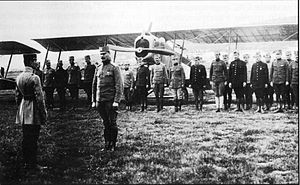- Dorand AR
-
Dorand AR.1 and AR.2 Dorand AR.2's of the first Serbian squadron Role Reconnaissance aircraft Manufacturer Section Technique de l'Aéronautique Designer Georges Lèpere First flight 1916 Introduction 1917 Primary users French Air Force
American Expeditionary Force
Serbian AviationThe Dorand AR.1 was a 1910s French two-seat observation biplane aircraft used by the French Air Force, Serbian Aviation, and the American Expeditionary Force.
Contents
Design and development
Designed by Captain Georges Lèpere of French Army Aircraft Establishment to replace the archaic Farman F.40 pusher aircraft, Dorand AR-series were two-seater reconnaissance biplanes that were named after the F.A.A.E's director, Lt. Col. Dorand. They were characterized by backward-staggered three-bay wings and highly angular all-moving tail surfaces. The pilot sat beneath the leading edge of the upper wing, with the observer's cockpit being under the trailing edge respectively, and there were cut-outs in both wings to improve the latter's visibility. Rather unusually for a single-engine tractor biplane of the era, the lower wing was not directly attached to the fuselage, instead being somewhat below it, supported by struts.
Production of these aircraft began in a state-owned French Army Aircraft Establishment (or S.T.Aé.) factory at Chalais-Meudon, near Paris, after flight testing had been completed in the autumn 1916.
Operational history
The first of the thirteen squadrons which flew Dorands on the Western Front received their aircraft in the spring 1917. Five other French squadrons used the type on the Italian Front. These aircraft were withdrawn from the combat units in early 1918.
In 1917 the American Expeditionary Force ordered the Renault-engined varieties of the Dorand, the first of 22 AR.1s being delivered in December 1917 and the first of 120 AR.2s in following February. The Americans operated these types on the Western Front for the first half 1918, until replacing them with the Salmson 2. After being retired from fighting duties, the surviving examples were used as trainers.
A number of Dorand AR.1s were also supplied to Kingdom of Serbia, which operated these aircraft in four squadrons from April 1918 onwards.
While the Dorand AR-types didn't have a particularly distinguished career in either French or American service, having a rather mediocre performance for a late-war daytime reconnaissance aircraft and suffering from having been warranted a low priority for engine supplies, it is a testimony to the general soundness of the design that after the war, many AR.1s and AR.2s appeared in the French civil register, being used as 2/3-passenger transports by companies like Compagnie Aérienne Française and Réseau Aérien Transafricain. Private users found the aircraft useful for training and joy-flights as well.
Variants
There were following variants of the design:
- AR.1
- 1st production version powered by a 200 hp (149 kW) Renault 8Gdy engine
- ARL.1
- AR.1s modified with a 185 hp Lorraine-Dietrich engine
- AR.2
- 2nd production version powered by a 190 hp (142 kW) Renault 8Ge engine
- ARL.2
- AR.2s modified with a 240 hp Lorraine-Dietrich engine
The AR.1 and ARL.1 had a wing span of 13,27 metres and used frontal radiators, while AR.2 and ARL.2 were slightly smaller aircraft with 12,00 metre wing span (wing area being 45 square metres) and wing mounted radiators. All these types had A2 added to their names in French service, indicating that they were being employed as two-seater reconnaissance aircraft.
Operators
Specifications (AR.1)
General characteristics
- Crew: 2, pilot and observer
- Length: 9.14 m (30 ft 0 in)
- Wingspan: 13.27 m (43 ft 7½ in)
- Height: m (ft in)
- Wing area: 50.17 m² (540 ft)
- Empty weight: kg (lb)
- Loaded weight: kg (lb)
- Useful load: kg (lb)
- Max takeoff weight: 1315 kg (2900 lb)
- Powerplant: 1 × Renault 8Gdy inline piston engine, 200 hp (149 kW)
Performance
- Never exceed speed: km/h (mph)
- Maximum speed: 148 km/h at 2000 m (92 mph at 6560 ft)
- Cruise speed: km/h (mph)
- Stall speed: km/h (mph)
- Range: 3 hours (of flying time)
- Service ceiling: 5500 m (ft)
- Rate of climb: minutes to m (minutes to ft)
- Wing loading: kg/m² (lb/ft²)
Armament
- 1 × fixed forward-firing .303 inch Vickers machine gun for the pilot
- 1 or 2 × Lewis gun(s) on a movable mounting for the observer
References
- Munson, Kenneth - Bombers, Patrol and Reconnaissance Aircraft 1914 - 1919 ISBN 0-7537-0918-X
See also
For the photographs of the Dorands see following pages:
- http://jnpassieux.chez-alice.fr/html/DorandAR1.php
- A history of military equipment of Modern Greece (1821-today): Dorand A.R.1
People and aircraft Campaigns and battles Strategic bombing (German, Cuxhaven) · Bombing of cities · Fokker Scourge · Flight over Vienna · Bloody April · BattlesEntente Powers air services Australian Flying Corps · British air services (Royal Flying Corps, Royal Naval Air Service, Royal Air Force) · French Air Service · Imperial Russian Air Force · Italian Military Air Corps · United States Army Air Service · Greek air services (Army Air Service, Naval Air Service)Central Powers air services German air services (Army Air Service, Navy Air Service) · Austro-Hungarian Imperial and Royal Aviation Troops · Ottoman Air Force · Bulgarian Army Aeroplane Section- Aircraft of comparable role, configuration and era
Royal Aircraft Factory R.E.8 - Albatros C.VII
Lists relating to aviation General Aircraft (manufacturers) · Aircraft engines (manufacturers) · Airlines (defunct) · Airports · Civil authorities · Museums · Registration prefixes · Rotorcraft (manufacturers) · TimelineMilitary Accidents/incidents Records Categories:- French military reconnaissance aircraft 1910–1919
- Military aircraft of World War I
- Biplane aircraft
- Propeller aircraft
- Single-engine aircraft
Wikimedia Foundation. 2010.


